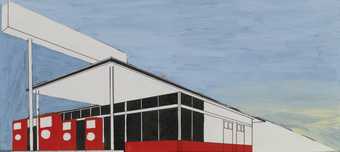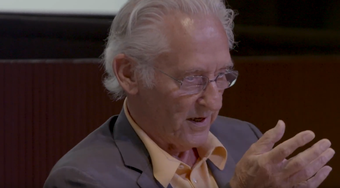Edward Ruscha, Pay Nothing Until April 2003. ARTIST ROOMS Tate and National Galleries of Scotland. © Ed Ruscha.
ARTIST ROOMS Ed Ruscha
Explore sixty years of work by influential American artist, Ed Ruscha
On a 1963 business card, Ed Ruscha explained how to pronounce his name (‘ED-WERD REW-SHAY’) and described himself simply as ‘young artist’. He began his career creating commercial graphics for a Los Angeles advertising agency in the 1960s. His subsequent work often references advertising, both in themes and technique. How words, sounds and images relate to each other is an ongoing fascination.
Using eye-catching type, Ruscha makes us expect a straightforward advertising slogan. Instead, he creates strange or contradictory images. He has said, ‘I’ve always had a deep respect for things that are odd, for things that cannot be explained. Explanations seem to me to sort of finish things off’.
This display reflects the range of Ruscha’s practice, including paintings, prints and photographic books. It includes examples of his use of unusual substances. DANCE? 1973 was made using coffee, egg white and mustard. Ruscha often draws inspiration from his adopted hometown of Los Angeles. Its architecture and imagery feature in much of his work. Full of irony and humour, his works can also be interpreted as commentaries on American society.
Ed Ruscha was born in 1937 in Omaha, Nebraska, USA. He lives and works in Los Angeles.
This display draws from ARTIST ROOMS, a touring collection of over 1,600 works of modern and contemporary art by 42 major artists. The collection is displayed across the UK through a touring programme, supported by Arts Council England, Art Fund and Creative Scotland. The ARTIST ROOMS collection is owned jointly by Tate and the National Galleries of Scotland and was established through The d’Offay Donation in 2008, with the assistance of the National Heritage Memorial Fund, Art Fund and the Scottish and British Governments.
The ARTIST ROOMS Gallery opened in the Blavatnik Building on 17 June 2016 with an exhibition of Louise Bourgeois, followed by Bruce Nauman in 2017 and Jenny Holzer in 2018.
The ARTIST ROOMS collection and national programme is managed by Tate and National Galleries of Scotland with the support of Art Fund, Henry Moore Foundation and the National Lottery through Arts Council England and Creative Scotland.
The collection was established through The d'Offay Donation in 2008 with the assistance of the National Heritage Memorial Fund, Art Fund and the Scottish and British Governments.
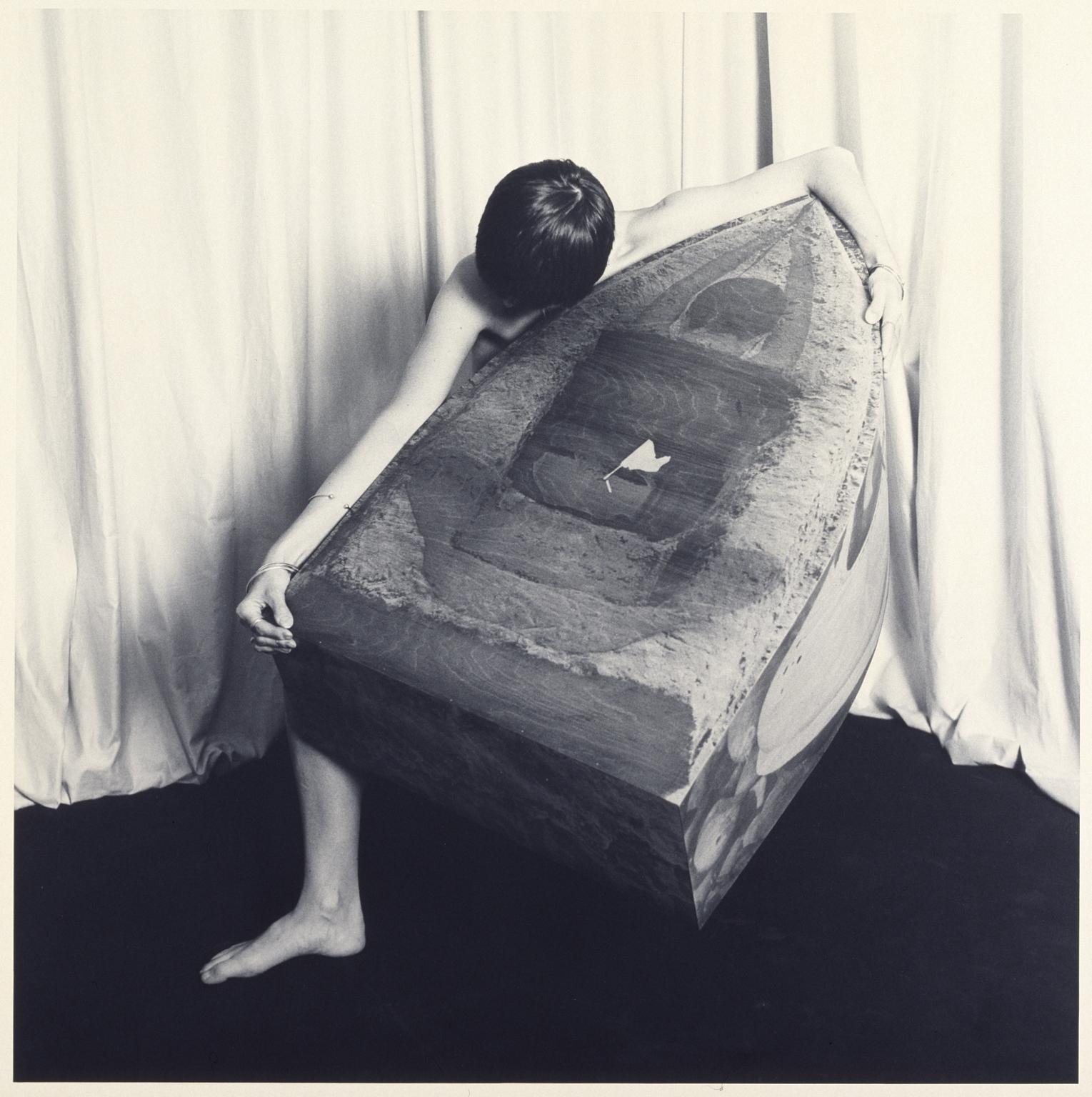
Helen Chadwick, The Labours IV 1983–4
Ego Geometria Sum 1983–6 consists in its entirety of ten laminated plywood sculptures, their surfaces covered with photographic images, and ten accompanying photographs. Initially titled ‘Growing Pains’, it charts the artist’s development from birth to the age of thirty through ten key stages of her life. These are embodied in ten geometric sculptures based on everyday objects of nostalgic significance from her past. Shadowy photographs of Chadwick’s naked body are superimposed with photographs of the original objects and other related elements on the geometric forms. Following the mathematical structure of a spiral, the sculptures correspond to dates increasingly far apart. When the work was first exhibited in the mid 1980s, at Aspex Gallery, Portsmouth (1983) and at the Institute of Contemporary Art, London (1986), the sculptures were installed in a spiral layout. The earliest, formative years of the artist’s life are accordingly represented most comprehensively. An incubator represents the artist’s premature birth, a font the artist at three months, a pram is the artist at ten months, a rowing boat marks two years, a wigwam five and a bed represents the artist at six and three-quarters. School years are represented by a piano for nine years, a gym-horse for eleven years and a perfect cube, subtitled High School, for thirteen years. Finally, the years fifteen to thirty are represented by a rectangular column, Statue, which is the height of the artist at the age of thirty and bears a life sized image of her standing body. The accompanying photographs, The Labours I–X 1983–4 (Tate P78657–P78666), show the naked artist holding or lifting each sculpture in front of theatrical drapes. They progress naturally, following the increasing size of the objects, from views of Chadwick on her knees tenderly cradling the ‘incubator’ and ‘font’ in The Labours I and II, to the culminating image of the artist bracing her body as she lifts the life-sized columnar representation of herself in The Labours X. Chadwick later explained:
1/24
artworks in Ed Ruscha

Helen Chadwick, The Labours VII 1983–4
Ego Geometria Sum 1983–6 consists in its entirety of ten laminated plywood sculptures, their surfaces covered with photographic images, and ten accompanying photographs. Initially titled ‘Growing Pains’, it charts the artist’s development from birth to the age of thirty through ten key stages of her life. These are embodied in ten geometric sculptures based on everyday objects of nostalgic significance from her past. Shadowy photographs of Chadwick’s naked body are superimposed with photographs of the original objects and other related elements on the geometric forms. Following the mathematical structure of a spiral, the sculptures correspond to dates increasingly far apart. When the work was first exhibited in the mid 1980s, at Aspex Gallery, Portsmouth (1983) and at the Institute of Contemporary Art, London (1986), the sculptures were installed in a spiral layout. The earliest, formative years of the artist’s life are accordingly represented most comprehensively. An incubator represents the artist’s premature birth, a font the artist at three months, a pram is the artist at ten months, a rowing boat marks two years, a wigwam five and a bed represents the artist at six and three-quarters. School years are represented by a piano for nine years, a gym-horse for eleven years and a perfect cube, subtitled High School, for thirteen years. Finally, the years fifteen to thirty are represented by a rectangular column, Statue, which is the height of the artist at the age of thirty and bears a life sized image of her standing body. The accompanying photographs, The Labours I–X 1983–4 (Tate P78657–P78666), show the naked artist holding or lifting each sculpture in front of theatrical drapes. They progress naturally, following the increasing size of the objects, from views of Chadwick on her knees tenderly cradling the ‘incubator’ and ‘font’ in The Labours I and II, to the culminating image of the artist bracing her body as she lifts the life-sized columnar representation of herself in The Labours X. Chadwick later explained:
2/24
artworks in Ed Ruscha
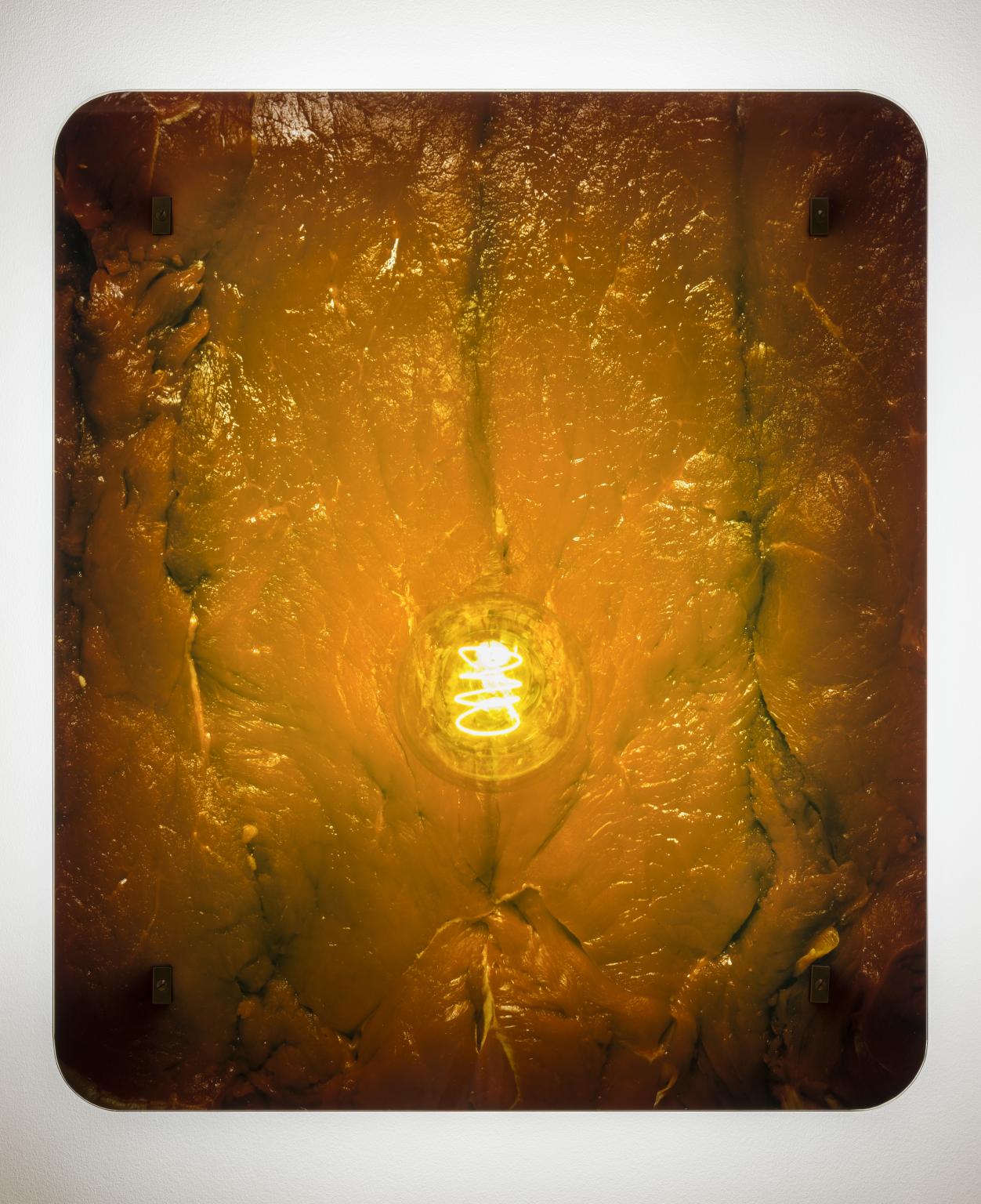
Helen Chadwick, Enfleshings I 1989
This work is part of a series of lightboxes called ‘Meat Lamps’. The artist used photographs of meat, including offal, combined with other materials. The works confront us with the reality of the human body as physical matter. Our ideas and feelings are generated within our flesh, not from some detached and superior position in relation to it.
Gallery label, May 2019
3/24
artworks in Ed Ruscha

Helen Chadwick, The Labours I 1983–4
Ego Geometria Sum 1983–6 consists in its entirety of ten laminated plywood sculptures, their surfaces covered with photographic images, and ten accompanying photographs. Initially titled ‘Growing Pains’, it charts the artist’s development from birth to the age of thirty through ten key stages of her life. These are embodied in ten geometric sculptures based on everyday objects of nostalgic significance from her past. Shadowy photographs of Chadwick’s naked body are superimposed with photographs of the original objects and other related elements on the geometric forms. Following the mathematical structure of a spiral, the sculptures correspond to dates increasingly far apart. When the work was first exhibited in the mid 1980s, at Aspex Gallery, Portsmouth (1983) and at the Institute of Contemporary Art, London (1986), the sculptures were installed in a spiral layout. The earliest, formative years of the artist’s life are accordingly represented most comprehensively. An incubator represents the artist’s premature birth, a font the artist at three months, a pram is the artist at ten months, a rowing boat marks two years, a wigwam five and a bed represents the artist at six and three-quarters. School years are represented by a piano for nine years, a gym-horse for eleven years and a perfect cube, subtitled High School, for thirteen years. Finally, the years fifteen to thirty are represented by a rectangular column, Statue, which is the height of the artist at the age of thirty and bears a life sized image of her standing body. The accompanying photographs, The Labours I–X 1983–4 (Tate P78657–P78666), show the naked artist holding or lifting each sculpture in front of theatrical drapes. They progress naturally, following the increasing size of the objects, from views of Chadwick on her knees tenderly cradling the ‘incubator’ and ‘font’ in The Labours I and II, to the culminating image of the artist bracing her body as she lifts the life-sized columnar representation of herself in The Labours X. Chadwick later explained:
4/24
artworks in Ed Ruscha
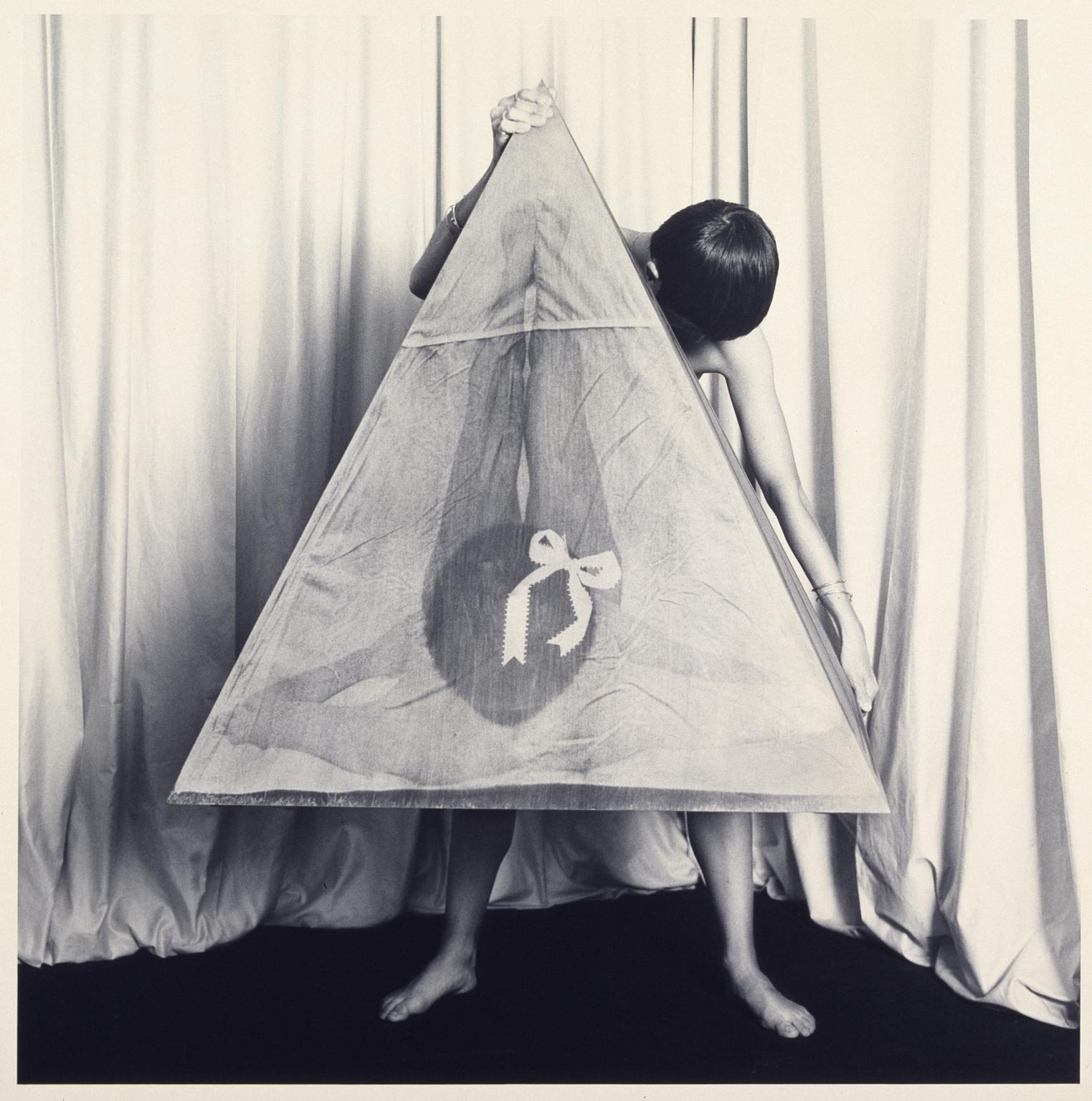
Helen Chadwick, The Labours V 1983–4
Ego Geometria Sum 1983–6 consists in its entirety of ten laminated plywood sculptures, their surfaces covered with photographic images, and ten accompanying photographs. Initially titled ‘Growing Pains’, it charts the artist’s development from birth to the age of thirty through ten key stages of her life. These are embodied in ten geometric sculptures based on everyday objects of nostalgic significance from her past. Shadowy photographs of Chadwick’s naked body are superimposed with photographs of the original objects and other related elements on the geometric forms. Following the mathematical structure of a spiral, the sculptures correspond to dates increasingly far apart. When the work was first exhibited in the mid 1980s, at Aspex Gallery, Portsmouth (1983) and at the Institute of Contemporary Art, London (1986), the sculptures were installed in a spiral layout. The earliest, formative years of the artist’s life are accordingly represented most comprehensively. An incubator represents the artist’s premature birth, a font the artist at three months, a pram is the artist at ten months, a rowing boat marks two years, a wigwam five and a bed represents the artist at six and three-quarters. School years are represented by a piano for nine years, a gym-horse for eleven years and a perfect cube, subtitled High School, for thirteen years. Finally, the years fifteen to thirty are represented by a rectangular column, Statue, which is the height of the artist at the age of thirty and bears a life sized image of her standing body. The accompanying photographs, The Labours I–X 1983–4 (Tate P78657–P78666), show the naked artist holding or lifting each sculpture in front of theatrical drapes. They progress naturally, following the increasing size of the objects, from views of Chadwick on her knees tenderly cradling the ‘incubator’ and ‘font’ in The Labours I and II, to the culminating image of the artist bracing her body as she lifts the life-sized columnar representation of herself in The Labours X. Chadwick later explained:
5/24
artworks in Ed Ruscha

Helen Chadwick, The Labours VI 1983–4
Ego Geometria Sum 1983–6 consists in its entirety of ten laminated plywood sculptures, their surfaces covered with photographic images, and ten accompanying photographs. Initially titled ‘Growing Pains’, it charts the artist’s development from birth to the age of thirty through ten key stages of her life. These are embodied in ten geometric sculptures based on everyday objects of nostalgic significance from her past. Shadowy photographs of Chadwick’s naked body are superimposed with photographs of the original objects and other related elements on the geometric forms. Following the mathematical structure of a spiral, the sculptures correspond to dates increasingly far apart. When the work was first exhibited in the mid 1980s, at Aspex Gallery, Portsmouth (1983) and at the Institute of Contemporary Art, London (1986), the sculptures were installed in a spiral layout. The earliest, formative years of the artist’s life are accordingly represented most comprehensively. An incubator represents the artist’s premature birth, a font the artist at three months, a pram is the artist at ten months, a rowing boat marks two years, a wigwam five and a bed represents the artist at six and three-quarters. School years are represented by a piano for nine years, a gym-horse for eleven years and a perfect cube, subtitled High School, for thirteen years. Finally, the years fifteen to thirty are represented by a rectangular column, Statue, which is the height of the artist at the age of thirty and bears a life sized image of her standing body. The accompanying photographs, The Labours I–X 1983–4 (Tate P78657–P78666), show the naked artist holding or lifting each sculpture in front of theatrical drapes. They progress naturally, following the increasing size of the objects, from views of Chadwick on her knees tenderly cradling the ‘incubator’ and ‘font’ in The Labours I and II, to the culminating image of the artist bracing her body as she lifts the life-sized columnar representation of herself in The Labours X. Chadwick later explained:
6/24
artworks in Ed Ruscha
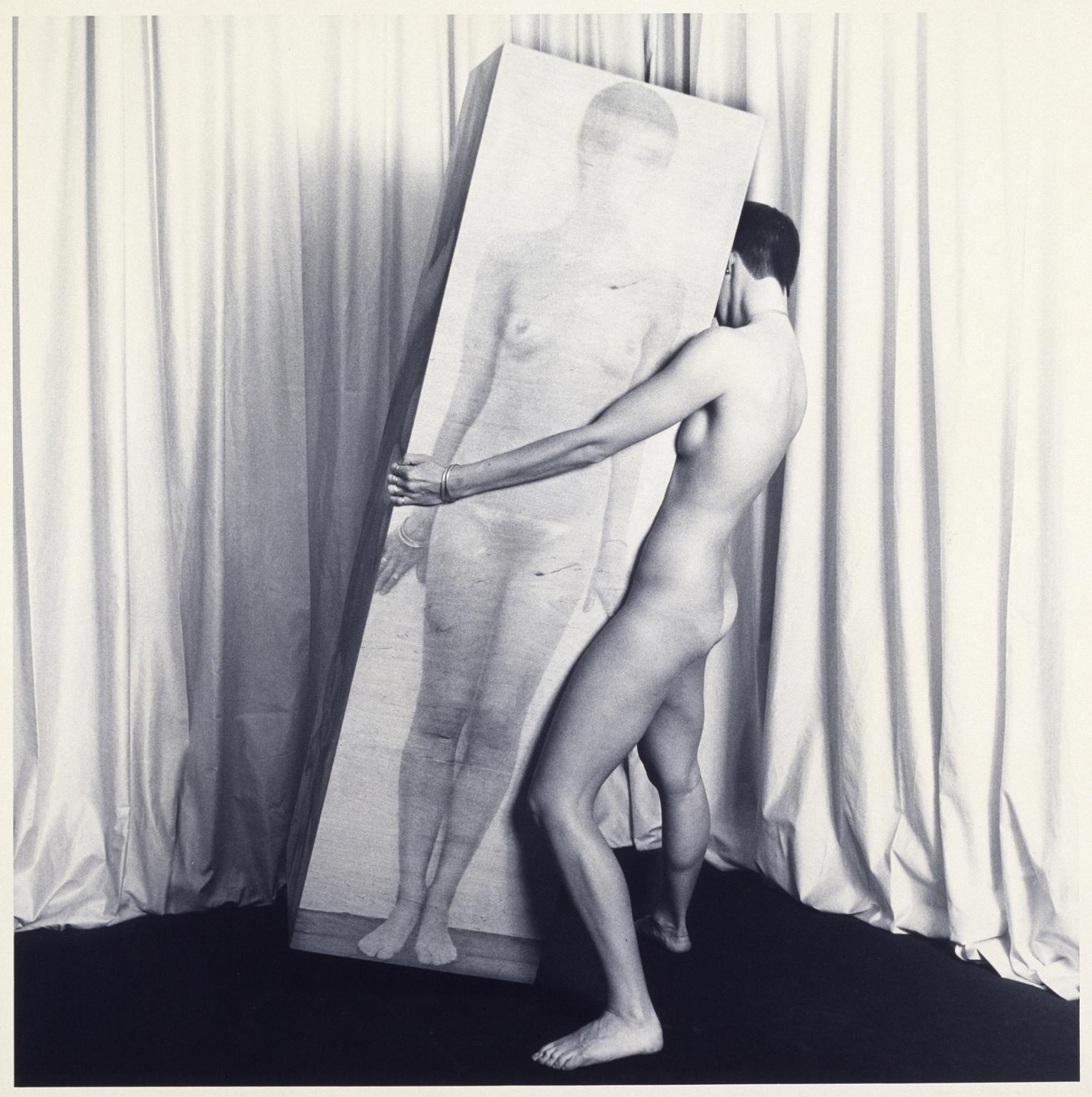
Helen Chadwick, The Labours X 1983–4
Ego Geometria Sum 1983–6 consists in its entirety of ten laminated plywood sculptures, their surfaces covered with photographic images, and ten accompanying photographs. Initially titled ‘Growing Pains’, it charts the artist’s development from birth to the age of thirty through ten key stages of her life. These are embodied in ten geometric sculptures based on everyday objects of nostalgic significance from her past. Shadowy photographs of Chadwick’s naked body are superimposed with photographs of the original objects and other related elements on the geometric forms. Following the mathematical structure of a spiral, the sculptures correspond to dates increasingly far apart. When the work was first exhibited in the mid 1980s, at Aspex Gallery, Portsmouth (1983) and at the Institute of Contemporary Art, London (1986), the sculptures were installed in a spiral layout. The earliest, formative years of the artist’s life are accordingly represented most comprehensively. An incubator represents the artist’s premature birth, a font the artist at three months, a pram is the artist at ten months, a rowing boat marks two years, a wigwam five and a bed represents the artist at six and three-quarters. School years are represented by a piano for nine years, a gym-horse for eleven years and a perfect cube, subtitled High School, for thirteen years. Finally, the years fifteen to thirty are represented by a rectangular column, Statue, which is the height of the artist at the age of thirty and bears a life sized image of her standing body. The accompanying photographs, The Labours I–X 1983–4 (Tate P78657–P78666), show the naked artist holding or lifting each sculpture in front of theatrical drapes. They progress naturally, following the increasing size of the objects, from views of Chadwick on her knees tenderly cradling the ‘incubator’ and ‘font’ in The Labours I and II, to the culminating image of the artist bracing her body as she lifts the life-sized columnar representation of herself in The Labours X. Chadwick later explained:
7/24
artworks in Ed Ruscha
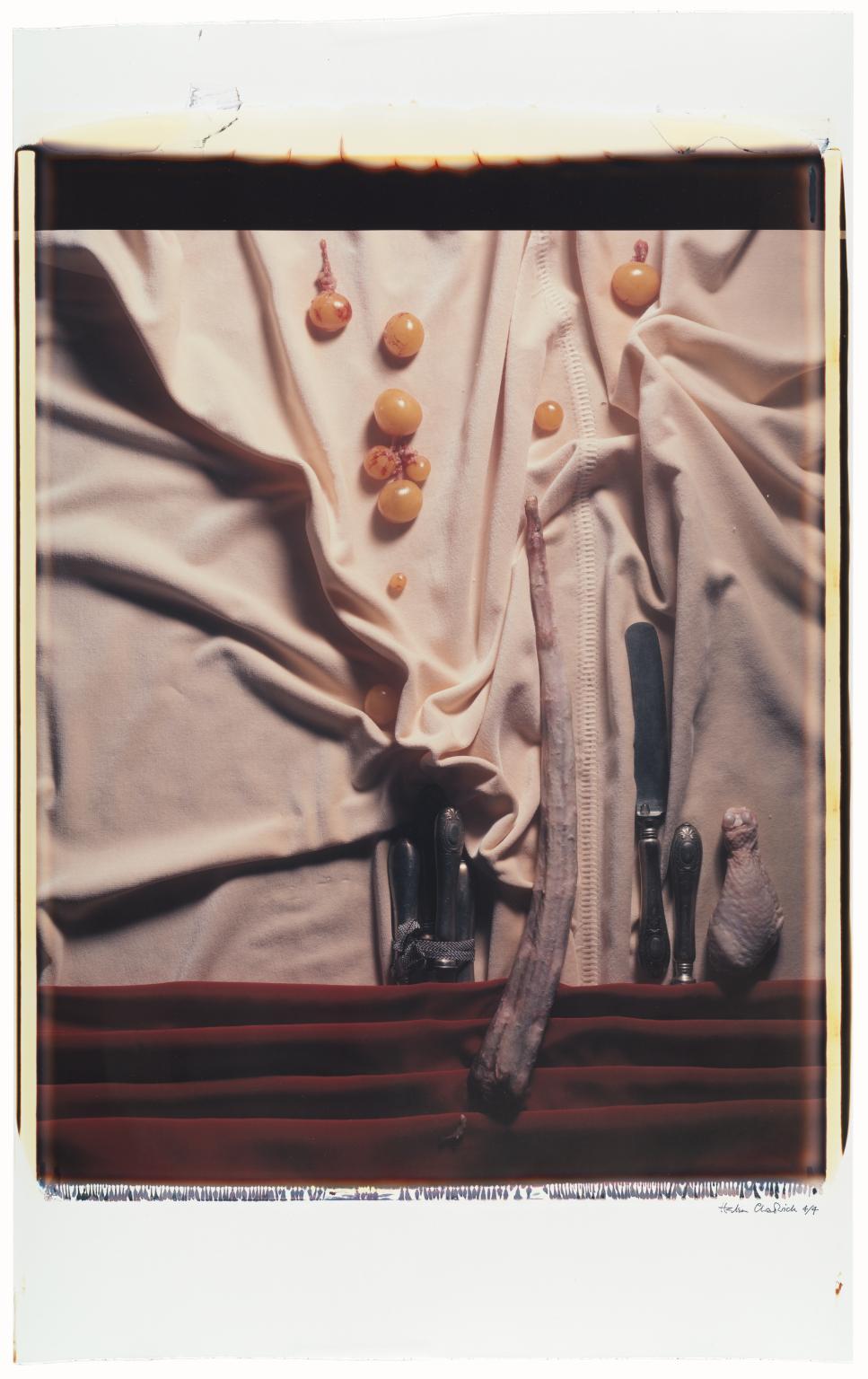
Helen Chadwick, No. 6: Cutlery 1989
This is one of a series of eight individually titled large-scale polaroid photographs from Helen Chadwick’s series Meat Abstracts 1989 (Tate P15568–P15575). In the late 1980s Chadwick’s work started to move away from traditional forms of self-representation. She stopped using her own, gendered body and started to work with meat and various forms of flesh, aiming towards a more universal image. Speaking of this development regarding her subject matter, she said: ‘I felt compelled to use materials that were still bodily, that were still a kind of self-portrait, but did not rely on the representation of my own body.’ (Quoted in Cocker 1996, p.23.)
8/24
artworks in Ed Ruscha

Helen Chadwick, No. 5: Heart of Liver 1989
This is one of a series of eight individually titled large-scale polaroid photographs from Helen Chadwick’s series Meat Abstracts 1989 (Tate P15568–P15575). In the late 1980s Chadwick’s work started to move away from traditional forms of self-representation. She stopped using her own, gendered body and started to work with meat and various forms of flesh, aiming towards a more universal image. Speaking of this development regarding her subject matter, she said: ‘I felt compelled to use materials that were still bodily, that were still a kind of self-portrait, but did not rely on the representation of my own body.’ (Quoted in Cocker 1996, p.23.)
9/24
artworks in Ed Ruscha
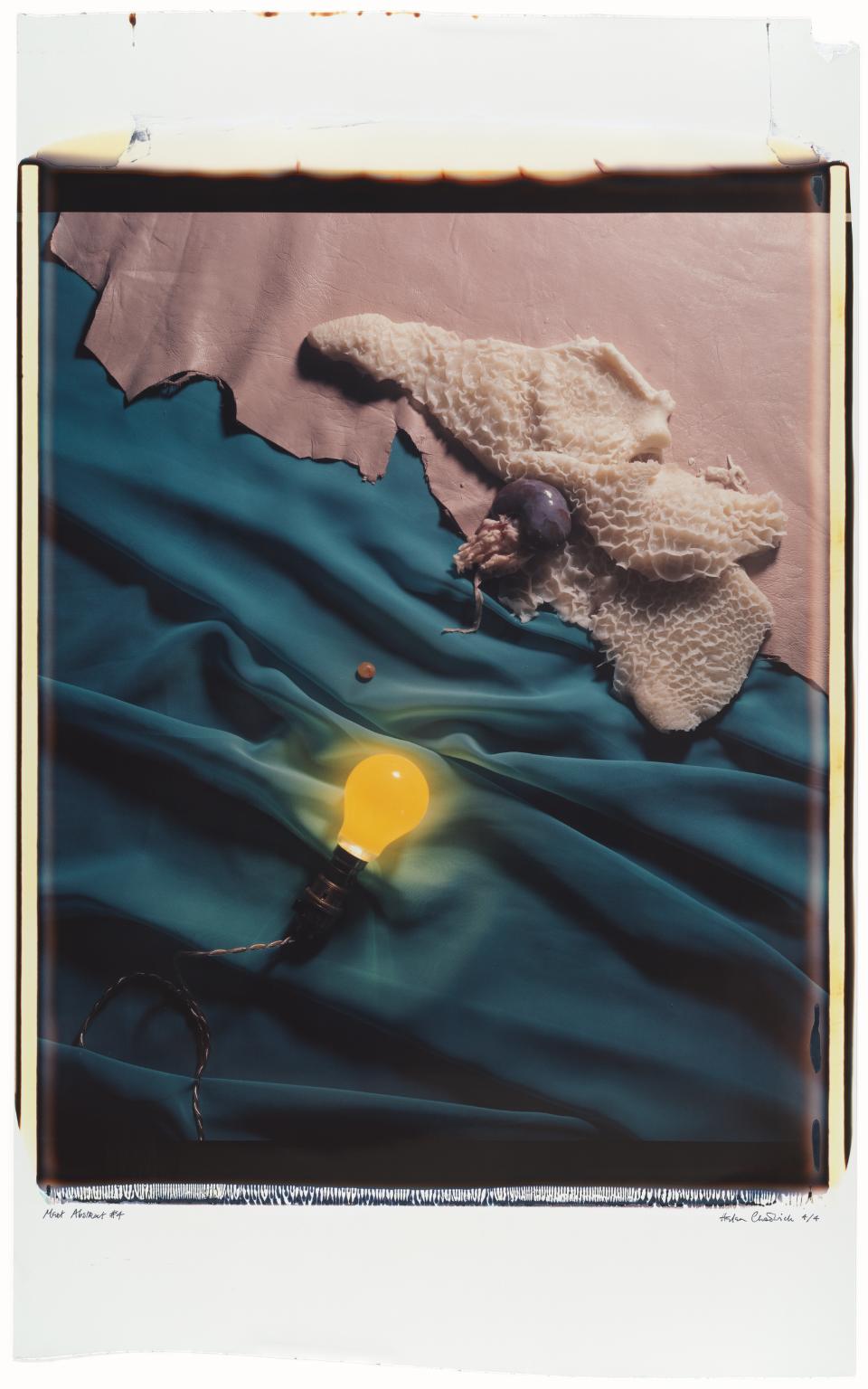
Helen Chadwick, No. 4: Tripe 1989
This is one of a series of eight individually titled large-scale polaroid photographs from Helen Chadwick’s series Meat Abstracts 1989 (Tate P15568–P15575). In the late 1980s Chadwick’s work started to move away from traditional forms of self-representation. She stopped using her own, gendered body and started to work with meat and various forms of flesh, aiming towards a more universal image. Speaking of this development regarding her subject matter, she said: ‘I felt compelled to use materials that were still bodily, that were still a kind of self-portrait, but did not rely on the representation of my own body.’ (Quoted in Cocker 1996, p.23.)
10/24
artworks in Ed Ruscha
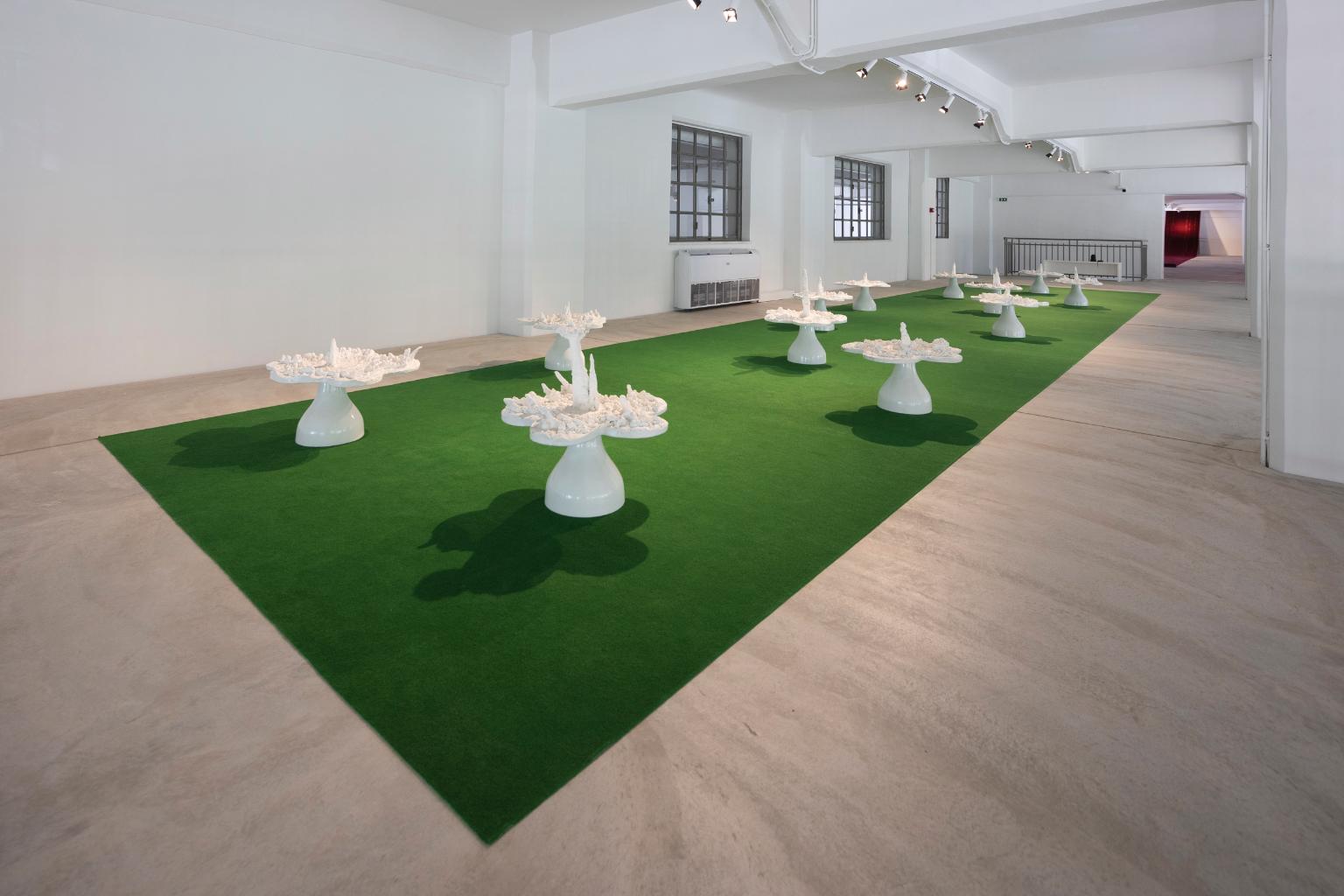
Helen Chadwick, Piss Flowers 1991–2
Piss Flowers 1991–2 is an installation consisting of twelve white flower-like sculptures that rest on a green carpet suggesting grass. The forms of the flowers were made, as alluded to in the work’s title, by taking casts of the void spaces left in snow by warm urine. The work was initiated during a residency that the artist undertook at the Banff Arts Centre in Alberta, Canada in February 1991. While staying in the cold climate, the artist and her partner, David Notarius, set off each day to a different location to make a mound of snow topped with a metal flower-shaped form. Chadwick and Notarius then urinated into the metal templates, after which they poured plaster into the cavities created by the hot urine. The resulting casts were shipped to Berlin, where the delicate forms were grafted onto pedestals based on the image of a hyacinth bulb. The works were subsequently cast in bronze and enameled in white lacquer. As a result of the inversion of negative and positive space, the sculptures playfully perform a gender reversal whereby the female bodily fluids produced the longer, penile form, while the male contribution created the petals and the labial forms.
11/24
artworks in Ed Ruscha

Helen Chadwick, The Labours II 1983–4
Ego Geometria Sum 1983–6 consists in its entirety of ten laminated plywood sculptures, their surfaces covered with photographic images, and ten accompanying photographs. Initially titled ‘Growing Pains’, it charts the artist’s development from birth to the age of thirty through ten key stages of her life. These are embodied in ten geometric sculptures based on everyday objects of nostalgic significance from her past. Shadowy photographs of Chadwick’s naked body are superimposed with photographs of the original objects and other related elements on the geometric forms. Following the mathematical structure of a spiral, the sculptures correspond to dates increasingly far apart. When the work was first exhibited in the mid 1980s, at Aspex Gallery, Portsmouth (1983) and at the Institute of Contemporary Art, London (1986), the sculptures were installed in a spiral layout. The earliest, formative years of the artist’s life are accordingly represented most comprehensively. An incubator represents the artist’s premature birth, a font the artist at three months, a pram is the artist at ten months, a rowing boat marks two years, a wigwam five and a bed represents the artist at six and three-quarters. School years are represented by a piano for nine years, a gym-horse for eleven years and a perfect cube, subtitled High School, for thirteen years. Finally, the years fifteen to thirty are represented by a rectangular column, Statue, which is the height of the artist at the age of thirty and bears a life sized image of her standing body. The accompanying photographs, The Labours I–X 1983–4 (Tate P78657–P78666), show the naked artist holding or lifting each sculpture in front of theatrical drapes. They progress naturally, following the increasing size of the objects, from views of Chadwick on her knees tenderly cradling the ‘incubator’ and ‘font’ in The Labours I and II, to the culminating image of the artist bracing her body as she lifts the life-sized columnar representation of herself in The Labours X. Chadwick later explained:
12/24
artworks in Ed Ruscha
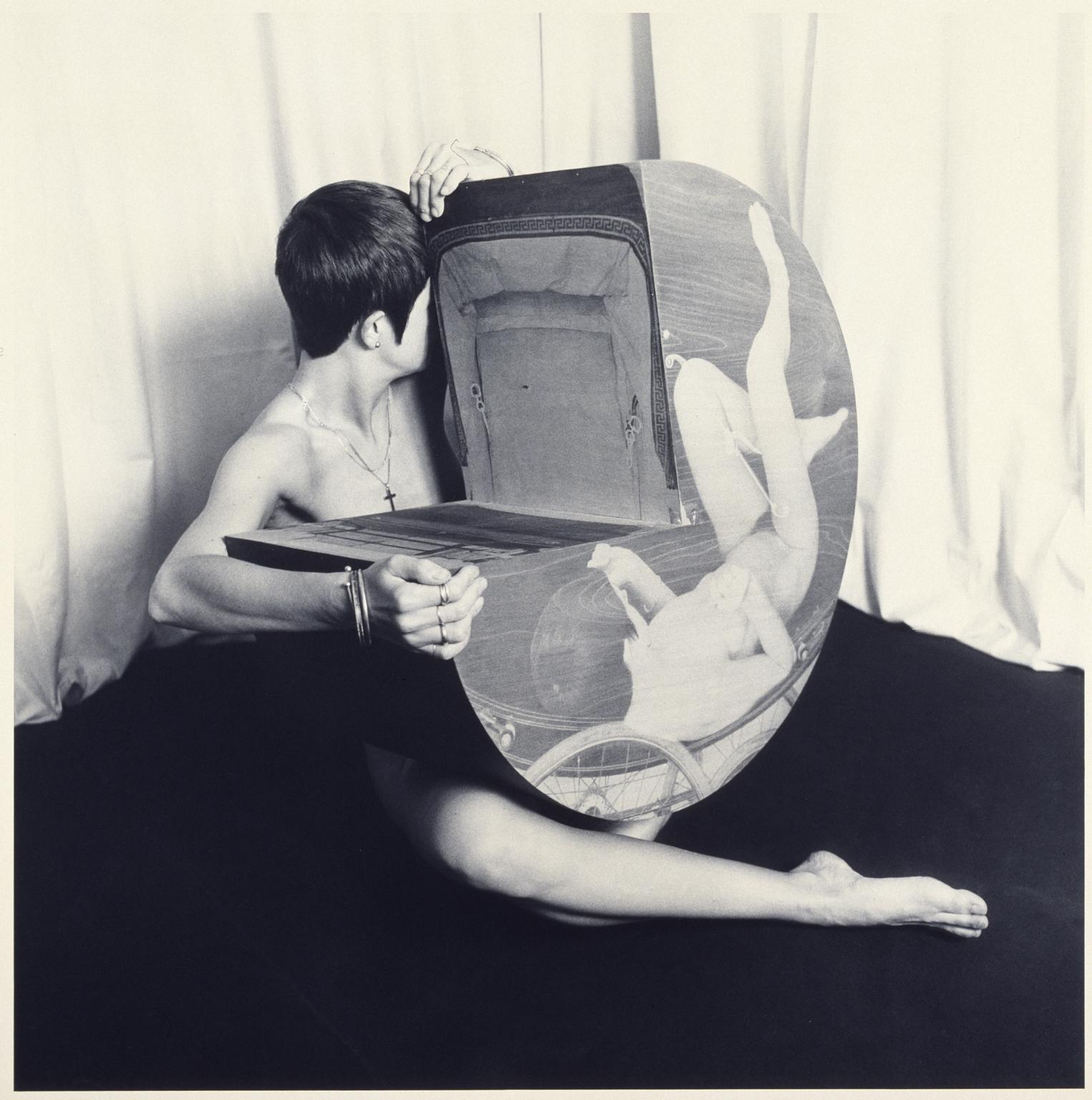
Helen Chadwick, The Labours III 1983–4
Ego Geometria Sum 1983–6 consists in its entirety of ten laminated plywood sculptures, their surfaces covered with photographic images, and ten accompanying photographs. Initially titled ‘Growing Pains’, it charts the artist’s development from birth to the age of thirty through ten key stages of her life. These are embodied in ten geometric sculptures based on everyday objects of nostalgic significance from her past. Shadowy photographs of Chadwick’s naked body are superimposed with photographs of the original objects and other related elements on the geometric forms. Following the mathematical structure of a spiral, the sculptures correspond to dates increasingly far apart. When the work was first exhibited in the mid 1980s, at Aspex Gallery, Portsmouth (1983) and at the Institute of Contemporary Art, London (1986), the sculptures were installed in a spiral layout. The earliest, formative years of the artist’s life are accordingly represented most comprehensively. An incubator represents the artist’s premature birth, a font the artist at three months, a pram is the artist at ten months, a rowing boat marks two years, a wigwam five and a bed represents the artist at six and three-quarters. School years are represented by a piano for nine years, a gym-horse for eleven years and a perfect cube, subtitled High School, for thirteen years. Finally, the years fifteen to thirty are represented by a rectangular column, Statue, which is the height of the artist at the age of thirty and bears a life sized image of her standing body. The accompanying photographs, The Labours I–X 1983–4 (Tate P78657–P78666), show the naked artist holding or lifting each sculpture in front of theatrical drapes. They progress naturally, following the increasing size of the objects, from views of Chadwick on her knees tenderly cradling the ‘incubator’ and ‘font’ in The Labours I and II, to the culminating image of the artist bracing her body as she lifts the life-sized columnar representation of herself in The Labours X. Chadwick later explained:
13/24
artworks in Ed Ruscha
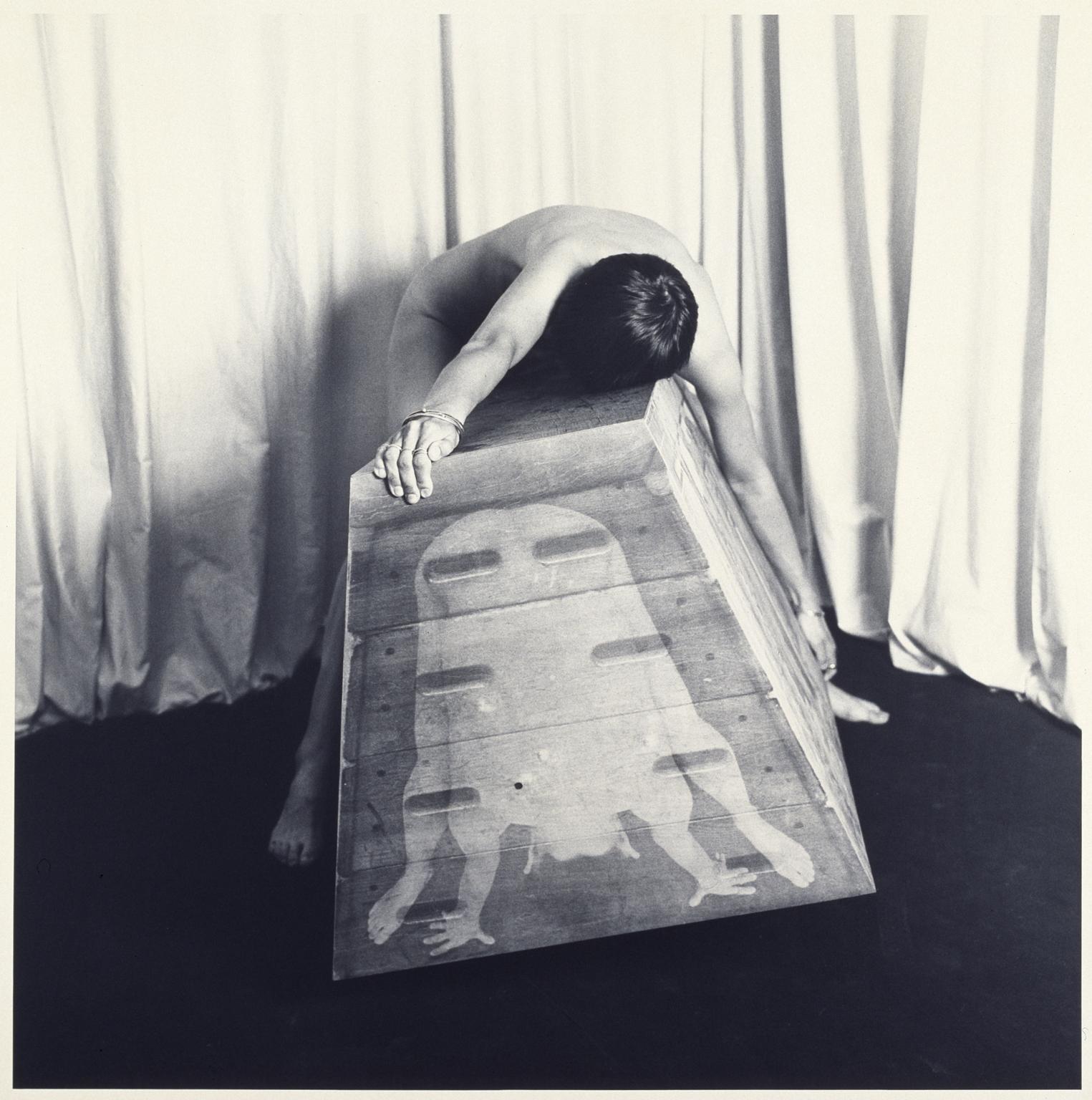
Helen Chadwick, The Labours VIII 1983–4
Ego Geometria Sum 1983–6 consists in its entirety of ten laminated plywood sculptures, their surfaces covered with photographic images, and ten accompanying photographs. Initially titled ‘Growing Pains’, it charts the artist’s development from birth to the age of thirty through ten key stages of her life. These are embodied in ten geometric sculptures based on everyday objects of nostalgic significance from her past. Shadowy photographs of Chadwick’s naked body are superimposed with photographs of the original objects and other related elements on the geometric forms. Following the mathematical structure of a spiral, the sculptures correspond to dates increasingly far apart. When the work was first exhibited in the mid 1980s, at Aspex Gallery, Portsmouth (1983) and at the Institute of Contemporary Art, London (1986), the sculptures were installed in a spiral layout. The earliest, formative years of the artist’s life are accordingly represented most comprehensively. An incubator represents the artist’s premature birth, a font the artist at three months, a pram is the artist at ten months, a rowing boat marks two years, a wigwam five and a bed represents the artist at six and three-quarters. School years are represented by a piano for nine years, a gym-horse for eleven years and a perfect cube, subtitled High School, for thirteen years. Finally, the years fifteen to thirty are represented by a rectangular column, Statue, which is the height of the artist at the age of thirty and bears a life sized image of her standing body. The accompanying photographs, The Labours I–X 1983–4 (Tate P78657–P78666), show the naked artist holding or lifting each sculpture in front of theatrical drapes. They progress naturally, following the increasing size of the objects, from views of Chadwick on her knees tenderly cradling the ‘incubator’ and ‘font’ in The Labours I and II, to the culminating image of the artist bracing her body as she lifts the life-sized columnar representation of herself in The Labours X. Chadwick later explained:
14/24
artworks in Ed Ruscha
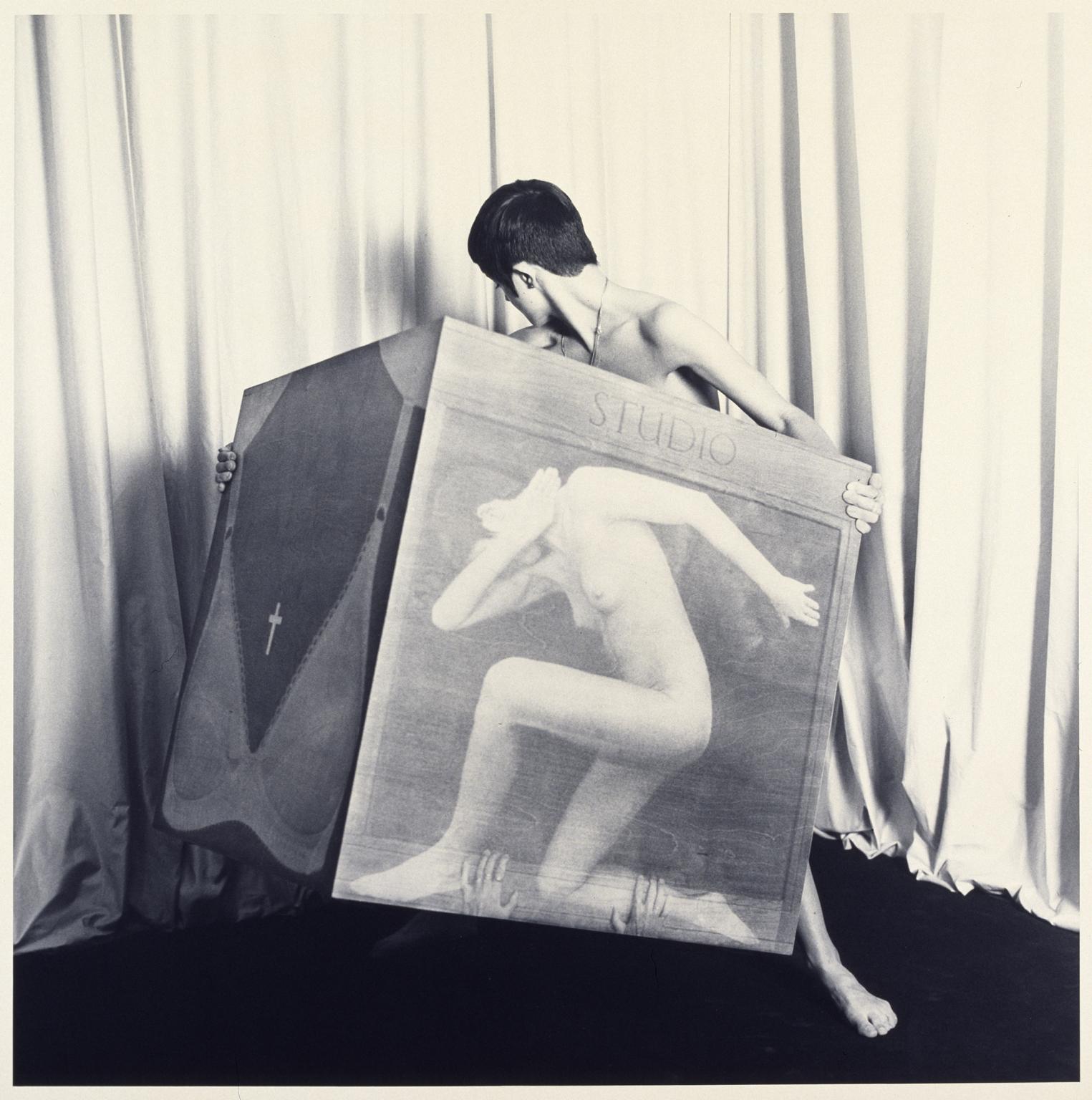
Helen Chadwick, The Labours IX 1983–4
Ego Geometria Sum 1983–6 consists in its entirety of ten laminated plywood sculptures, their surfaces covered with photographic images, and ten accompanying photographs. Initially titled ‘Growing Pains’, it charts the artist’s development from birth to the age of thirty through ten key stages of her life. These are embodied in ten geometric sculptures based on everyday objects of nostalgic significance from her past. Shadowy photographs of Chadwick’s naked body are superimposed with photographs of the original objects and other related elements on the geometric forms. Following the mathematical structure of a spiral, the sculptures correspond to dates increasingly far apart. When the work was first exhibited in the mid 1980s, at Aspex Gallery, Portsmouth (1983) and at the Institute of Contemporary Art, London (1986), the sculptures were installed in a spiral layout. The earliest, formative years of the artist’s life are accordingly represented most comprehensively. An incubator represents the artist’s premature birth, a font the artist at three months, a pram is the artist at ten months, a rowing boat marks two years, a wigwam five and a bed represents the artist at six and three-quarters. School years are represented by a piano for nine years, a gym-horse for eleven years and a perfect cube, subtitled High School, for thirteen years. Finally, the years fifteen to thirty are represented by a rectangular column, Statue, which is the height of the artist at the age of thirty and bears a life sized image of her standing body. The accompanying photographs, The Labours I–X 1983–4 (Tate P78657–P78666), show the naked artist holding or lifting each sculpture in front of theatrical drapes. They progress naturally, following the increasing size of the objects, from views of Chadwick on her knees tenderly cradling the ‘incubator’ and ‘font’ in The Labours I and II, to the culminating image of the artist bracing her body as she lifts the life-sized columnar representation of herself in The Labours X. Chadwick later explained:
15/24
artworks in Ed Ruscha
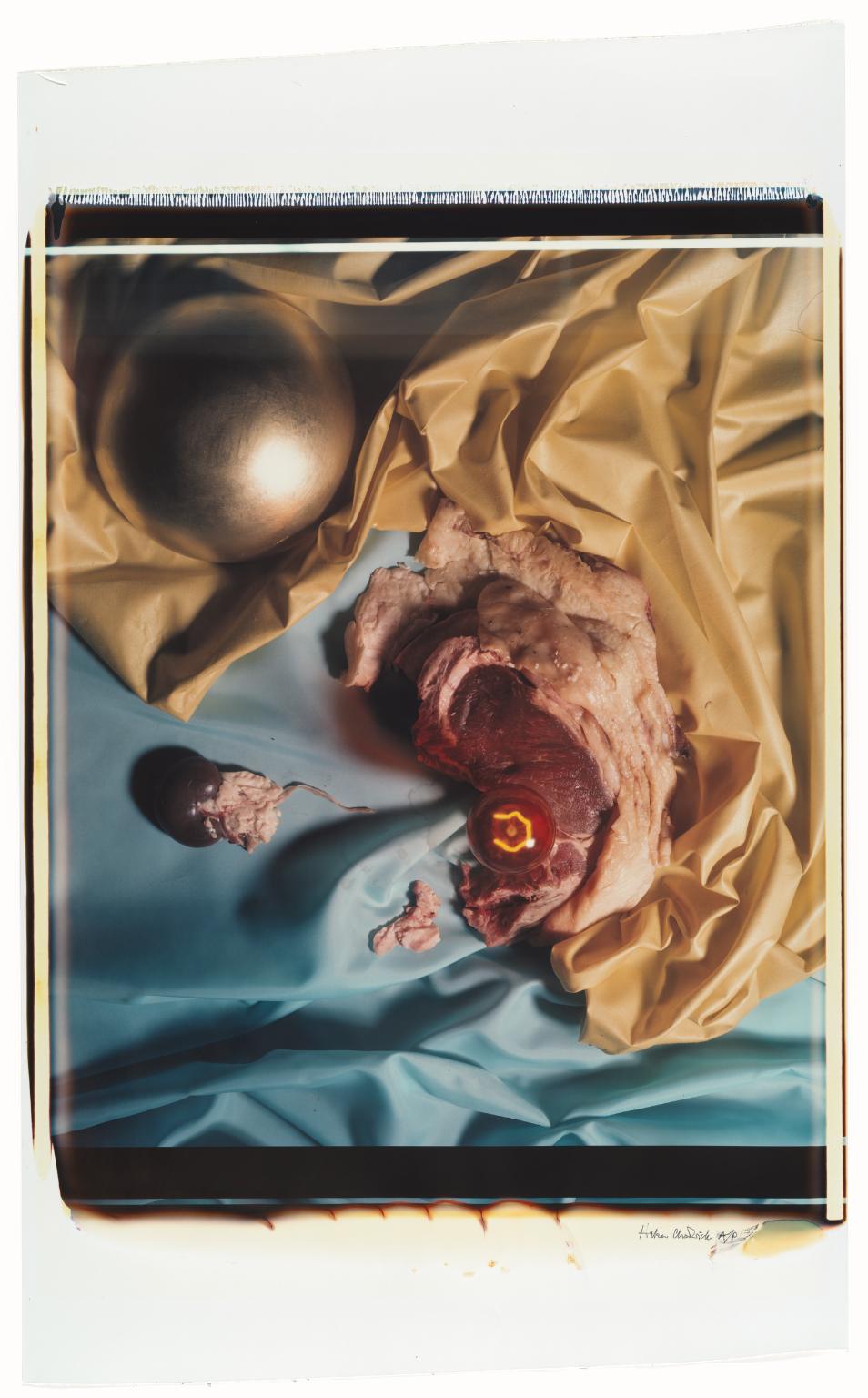
Helen Chadwick, No. 8: Gold Balls/Steak 1989
This is one of a series of eight individually titled large-scale polaroid photographs from Helen Chadwick’s series Meat Abstracts 1989 (Tate P15568–P15575). In the late 1980s Chadwick’s work started to move away from traditional forms of self-representation. She stopped using her own, gendered body and started to work with meat and various forms of flesh, aiming towards a more universal image. Speaking of this development regarding her subject matter, she said: ‘I felt compelled to use materials that were still bodily, that were still a kind of self-portrait, but did not rely on the representation of my own body.’ (Quoted in Cocker 1996, p.23.)
16/24
artworks in Ed Ruscha

Helen Chadwick, No. 7: Hair and Entrails 1989
This is one of a series of eight individually titled large-scale polaroid photographs from Helen Chadwick’s series Meat Abstracts 1989 (Tate P15568–P15575). In the late 1980s Chadwick’s work started to move away from traditional forms of self-representation. She stopped using her own, gendered body and started to work with meat and various forms of flesh, aiming towards a more universal image. Speaking of this development regarding her subject matter, she said: ‘I felt compelled to use materials that were still bodily, that were still a kind of self-portrait, but did not rely on the representation of my own body.’ (Quoted in Cocker 1996, p.23.)
17/24
artworks in Ed Ruscha
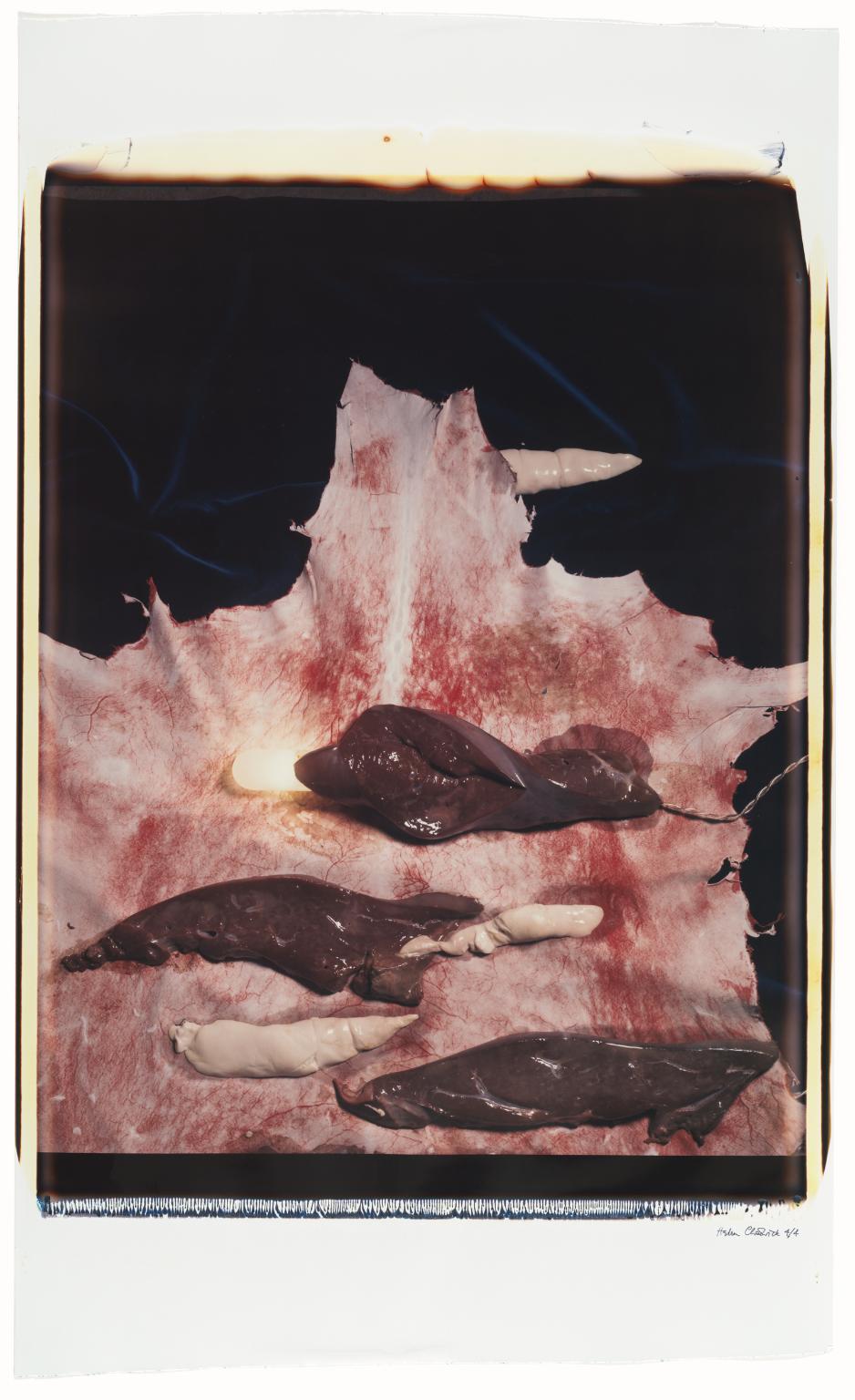
Helen Chadwick, No. 3: Liver 1989
This is one of a series of eight individually titled large-scale polaroid photographs from Helen Chadwick’s series Meat Abstracts 1989 (Tate P15568–P15575). In the late 1980s Chadwick’s work started to move away from traditional forms of self-representation. She stopped using her own, gendered body and started to work with meat and various forms of flesh, aiming towards a more universal image. Speaking of this development regarding her subject matter, she said: ‘I felt compelled to use materials that were still bodily, that were still a kind of self-portrait, but did not rely on the representation of my own body.’ (Quoted in Cocker 1996, p.23.)
18/24
artworks in Ed Ruscha
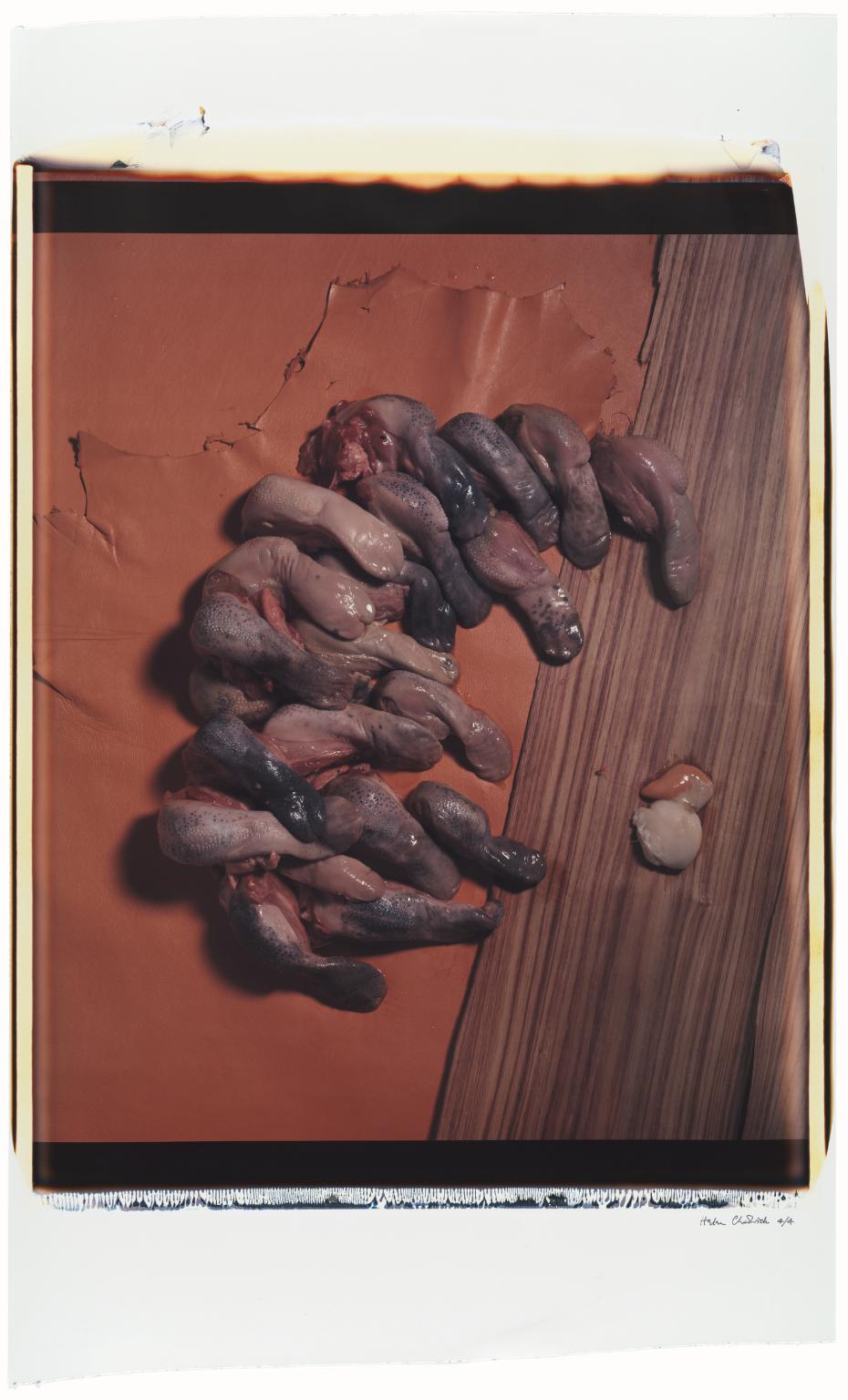
Helen Chadwick, No. 2: Tongues 1989
This is one of a series of eight individually titled large-scale polaroid photographs from Helen Chadwick’s series Meat Abstracts 1989 (Tate P15568–P15575). In the late 1980s Chadwick’s work started to move away from traditional forms of self-representation. She stopped using her own, gendered body and started to work with meat and various forms of flesh, aiming towards a more universal image. Speaking of this development regarding her subject matter, she said: ‘I felt compelled to use materials that were still bodily, that were still a kind of self-portrait, but did not rely on the representation of my own body.’ (Quoted in Cocker 1996, p.23.)
19/24
artworks in Ed Ruscha

Helen Chadwick, Anatoli 1989
20/24
artworks in Ed Ruscha
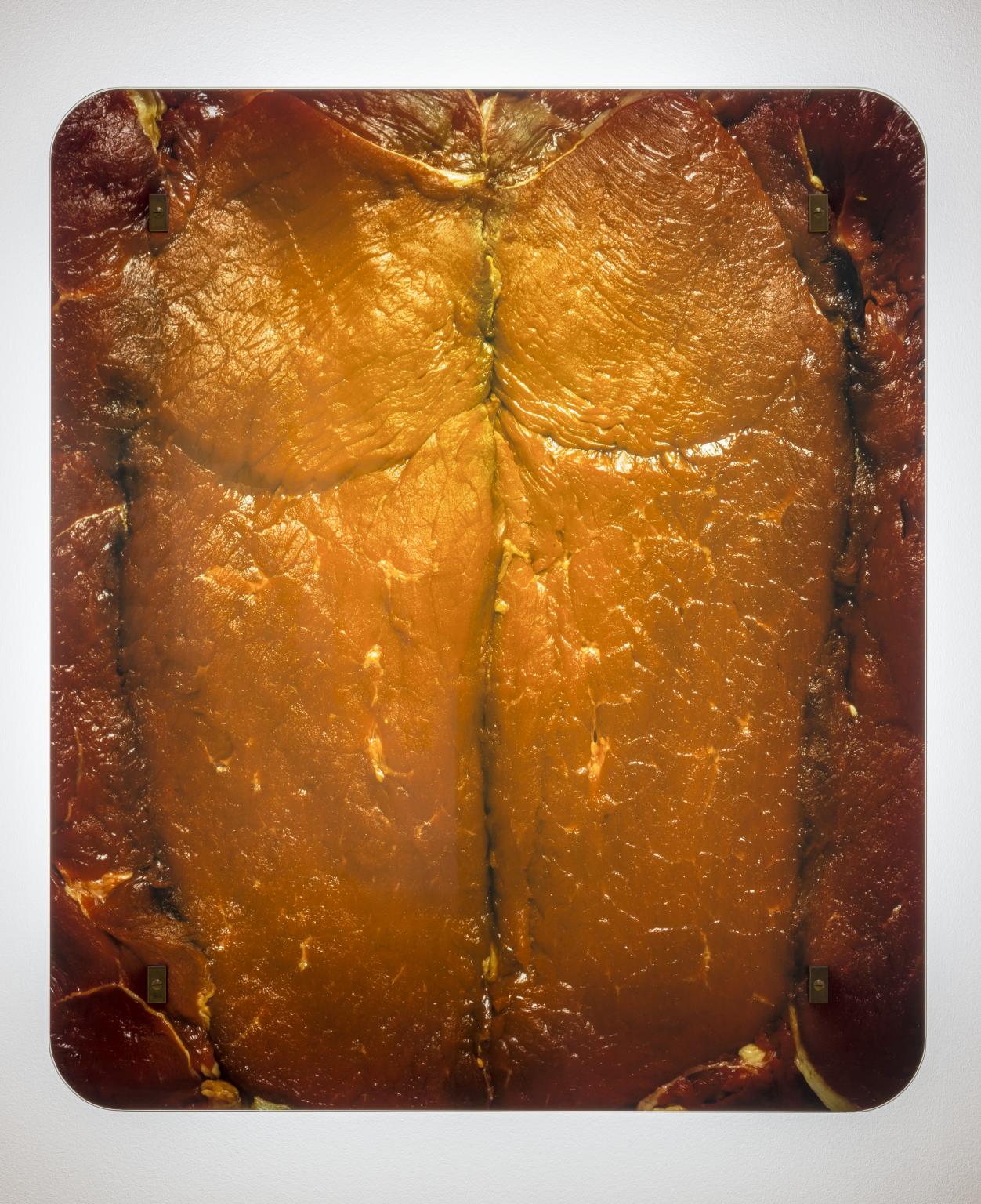
Helen Chadwick, Enfleshings II 1989
This work is part of a series of lightboxes called ‘Meat Lamps’. The artist used photographs of meat, including offal, combined with other materials. The works confront us with the reality of the human body as physical matter. Our ideas and feelings are generated within our flesh, not from some detached and superior position in relation to it.
Gallery label, May 2019
21/24
artworks in Ed Ruscha
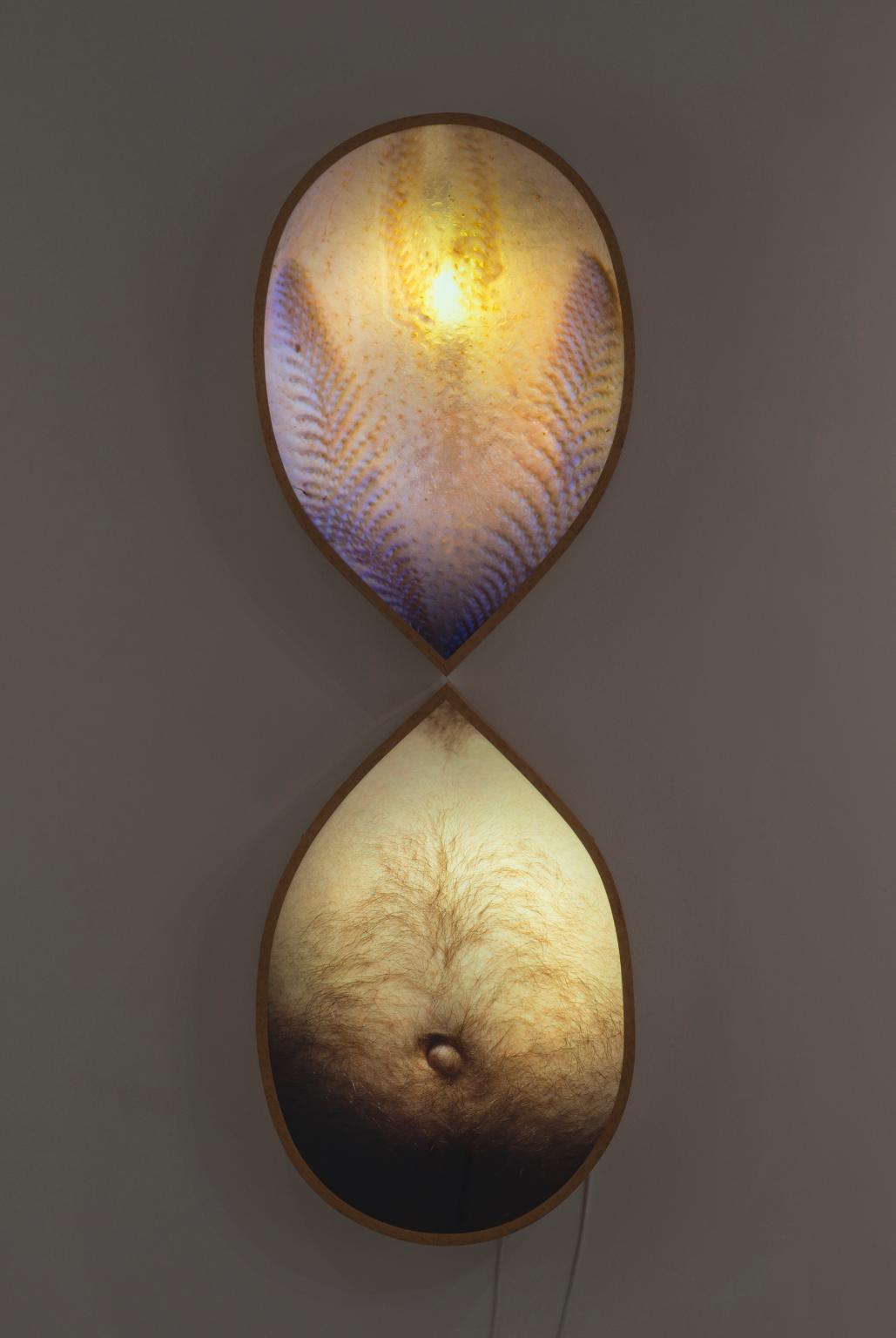
Helen Chadwick, Philosopher’s Fear of Flesh 1989
Philosopher’s Fear of Flesh 1989 is composed of two transparencies conjoined in a birds-eye maple lightbox, the opaque maple sides of which contain the illumination within the images, preventing light from spilling out onto the surrounding walls. The work’s seemingly base subject matter, bringing together photographs of chicken skin and a hairy male belly, is depicted in a formal symmetrical arrangement that recalls an hourglass shape. The lightbox that holds the two images together takes the form of an infinity sign, both juxtaposing and conjoining the human and animal, the spiritual and carnal. The work’s title pokes fun at this juxtaposition, taking aim at the philosophical preoccupation with separating ideas of the mind, associated with humanity and culture, from the bodily realm of the animal and natural.
22/24
artworks in Ed Ruscha
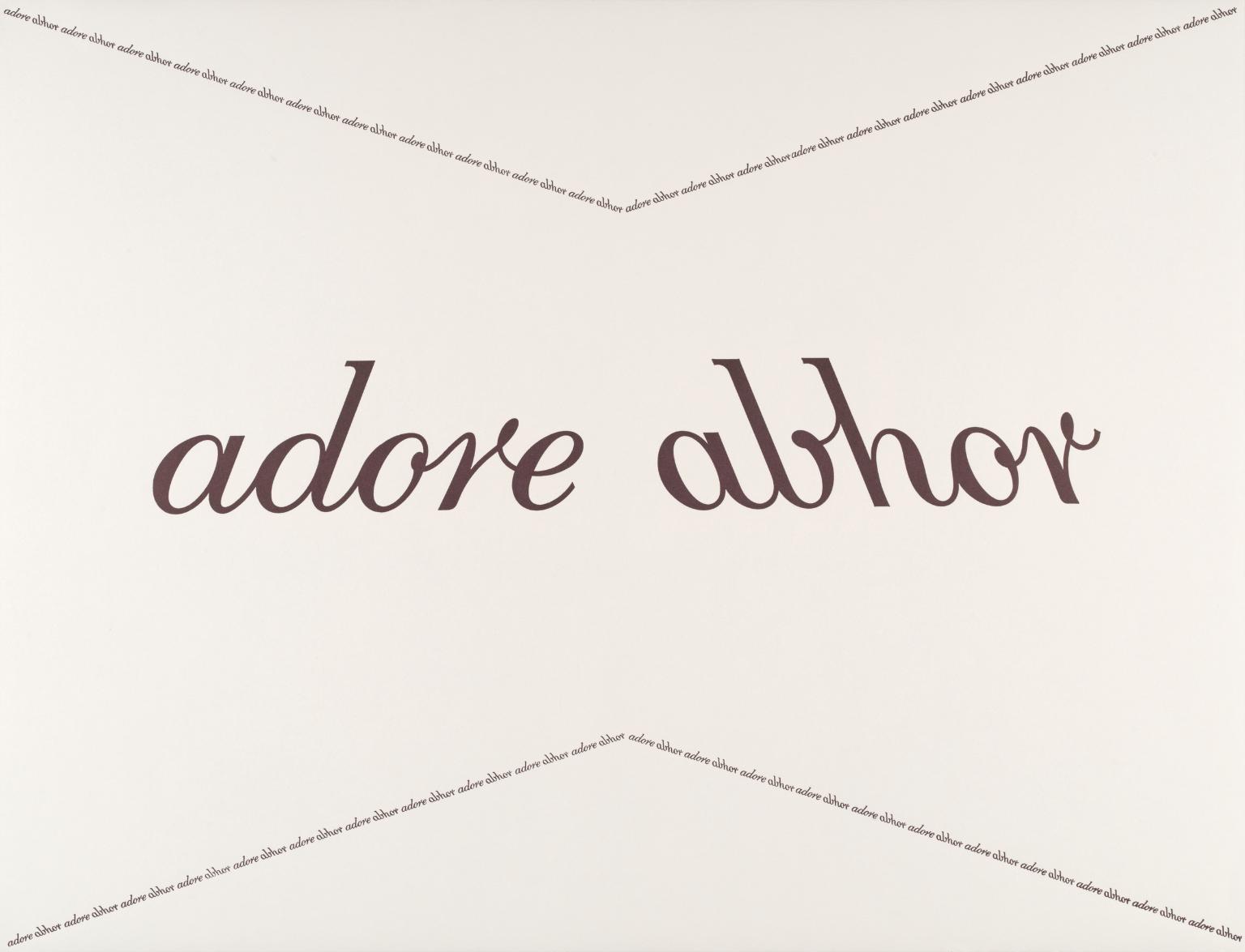
Helen Chadwick, [no title] 1994
Other Men's Flowers is a portfolio of text-based prints by fifteen London artists curated by Joshua Compston (1970-96). It was printed by Thomas Shaw and Simon Redington and published by Charles Booth-Clibborn under his imprint, The Paragon Press. Compston took the title, Other Men's Flowers, from an anthology of wartime poetry compiled by Field-Marshal Viscount Wavell (1883-1950) of the same title (published 1944). Wavell had derived the phrase from a well-known quotation attributed to French moralist Montaigne (Michel Eyquem de Montaigne, 1533-92), 'I have gathered a posie of other men's flowers and nothing but the thread which binds them is my own' (quoted in Cooper, p.115). Montaigne's original sentence, published in his Essais (Essays) in 1580, provided an apparently modest disclaimer, anticipating criticism of the originality of his ideas. For Compston, it provided an apt poetic metaphor for the role of the curator. Other Men's Flowers was launched at a party on 23 June 1994 in a derelict sawmill close to Hoxton Square, East London, a centre for young British artists at that time. Compston wrote in his press release: The project has produced an exciting and innovative publication that intrinsically embodies the elegant but underused printing technique of letterpress … that has allowed and encouraged many hitherto solely image-based artists an opportunity to operate within the realms of 'copy writing', providing them with a platform from which to sound off any phrase, slang discovery, polemical essay or related literary form … the participants produced works that responded to the given brief of a letterpress printed text piece. (Quoted in Cooper, p.116.) Letterpress is a form of relief printing in which paper is pressed, by either a large flat plate or rollers, onto previously inked type. In the event, nine of the fifteen participants adhered to Compston's letterpress brief. Of the remaining six, four produced screenprint images, one a lithograph and one a monotype. The individual artists used different types of paper, all of the same size, some working in landscape and others in portrait format. The portfolio was produced in two slightly different editions. The 'book' edition, of one hundred copies plus twenty artist's proofs, consists of fifteen prints, three title pages and a colophon page signed by all the artists, presented in a box. Tate's copy is number twelve in this edition. The 'portfolio' edition of fifty, plus twenty artist's proofs, differs only in that the prints are individually signed. The three title pages were designed by Compston and contain the following: the title words in large blue capitals, the words 'An Introduction to Other Men's Flowers' above a drawing of a pointing hand in the style of an Edwardian cartoon, the words 'Please Keep Out/ Foot & Mouth Precautions' in large red capitals copied from a National Union of Farmers poster of the 1960s. The colophon page, on which the artists, curator, printers and publishers are named and the editions described, bears the circled logo 'OMF' in red. This logo is a typical Compston mechanism and imitates his personal 'FN' (Factual Nonsense) logo. Compston set up Factual Nonsense, his gallery and project space, in Shoreditch, London in October 1992, shortly after graduating in art history from the Courtauld Institute in London. Aiming to establish a cultural revolution of some kind, he intended his space to be 'a forum for all elements disenchanted with the laxity and ennui of current thinking' (quoted in Cooper, pp.39-42). He befriended many members of the group of young British artists (or yBas) whose work was just coming to prominence in London at that time. Between 1993 and his tragically premature death in 1996 at the age of twenty-five, he organised exhibitions and performative day events in Hoxton Square, as well as commissioning the pages of Other Men's Flowers from his artist friends.
23/24
artworks in Ed Ruscha
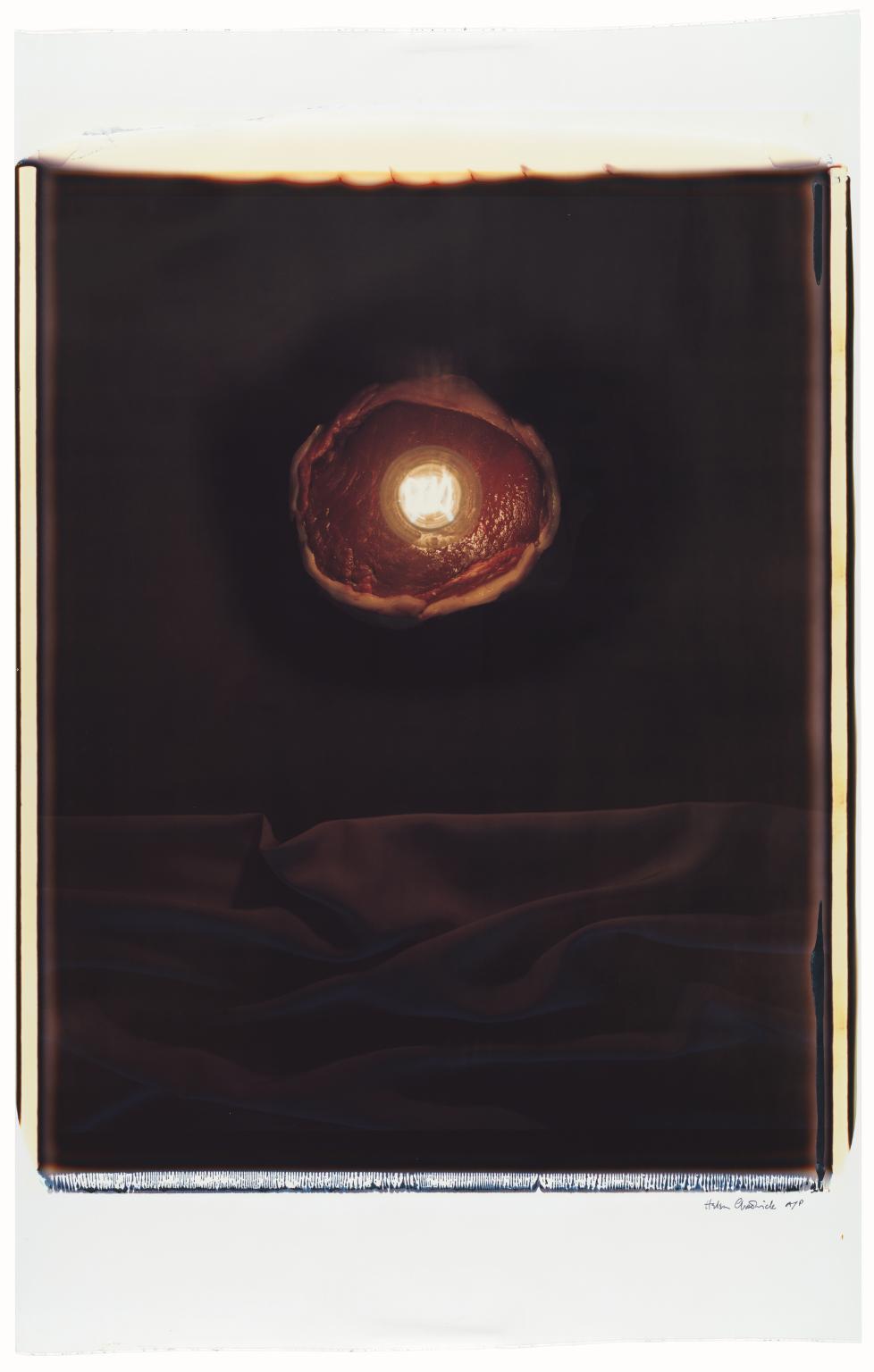
Helen Chadwick, No. 1: Black Sun 1989
This is one of a series of eight individually titled large-scale polaroid photographs from Helen Chadwick’s series Meat Abstracts 1989 (Tate P15568–P15575). In the late 1980s Chadwick’s work started to move away from traditional forms of self-representation. She stopped using her own, gendered body and started to work with meat and various forms of flesh, aiming towards a more universal image. Speaking of this development regarding her subject matter, she said: ‘I felt compelled to use materials that were still bodily, that were still a kind of self-portrait, but did not rely on the representation of my own body.’ (Quoted in Cocker 1996, p.23.)
24/24
artworks in Ed Ruscha
Art in this room






















![P11434: [no title]](https://media.tate.org.uk/art/images/work/P/P11/P11434_10.jpg)

You've viewed 6/24 artworks
You've viewed 24/24 artworks

